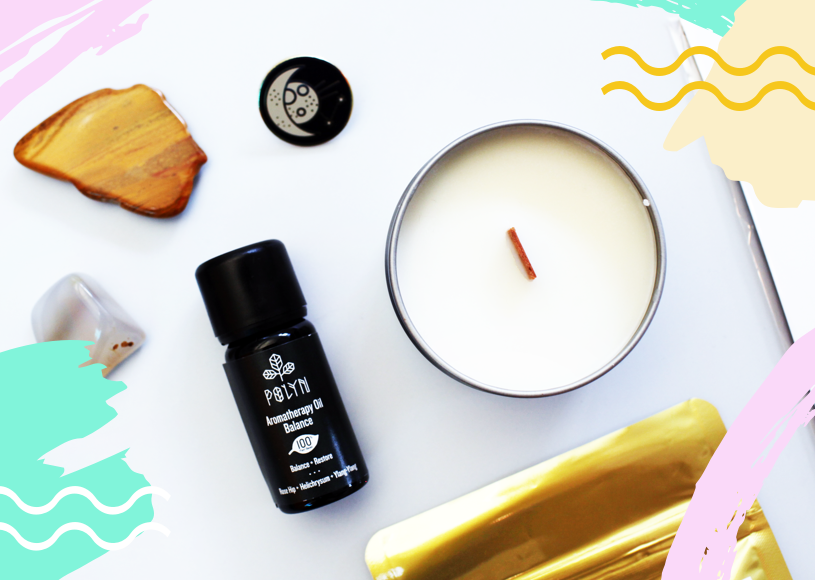One of the most common questions behind starting a subscription business is this: where do I find the products I include in my monthly box?
It’s a question about product sourcing, also called “procurement,” and it’s this operation that often determines subscriber happiness, loyalty, and the likelihood of referrals.
Watch: Check out Subscription School’s 60-minute webinar on Product Sourcing for Subscription Boxes
Needless to say, sourcing high-quality, targeted products for your niche is critical to your business’ success. To help with just that, below we’ve laid out 7 places where you can source products for your subscription box. Specifically, we’ll discuss:
Before You Start: Free or Paid?
Before you start procuring your first box, you need to decide between two purchasing models behind subscription boxes: sourcing free products or sourcing products you pay for.
The difference is significant, and not just for your business’ pocketbook.
Free product sourcing means:
- Improved inherent margins for your subscription business (since there’s no cost for products)
- Pitching your vendor partners on other value outside of monetary compensation
- Potentially impacted product offering (free sourcing usually works best with small, sample or trial-sized items)
- Potentially drives your price down (depends on the quantity/quality of items – or samples – included)
- Requires the vendor to eat the cost of ingredients and packaging
Purchasing products means:
- Potentially lower margins or higher price for customers
- Usually faster & easier negotiations with vendors
- Works with both sample and full-sized items
Once you know if you’re purchasing items or sourcing them for free, you’re ready to start targeting your vendor partners. (And remember, you could do both!)
1. Local Stores
Local stores are great starting places to get inspiration for the types of products you want to include. While they may not be the vendors you buy from, finding a targeted local store within your niche will provide a treasure trove of items you can physically test inside your box.
Some examples might be walking into your local Whole Foods, Bass Pro Shops, Crate & Barrel, or Hot Topic. The idea is to go to a store that represents your niche – something that attracts the same demographic your business looks for.
Tips:
- In addition to using the stores for inspiration, use them for prototype box products. Buy the items you’re considering reaching out to, and place them in your box to get a sense of how they’d affect packing configuration.
- Use Evernote or other tools to take pictures and track which products work with your box.
- In some cases, you may be able to work with the owner of a local store if they produce their own goods (like a local candle shop, bath & body goods store, or craft/clothing vendor).
2. Google (or your search engine of choice)
Search engines are the supermarket of the Internet when it comes to sourcing for your subscription box. The downside is you have tons to go through.
Because of the sheer volume of results, the best strategy is to narrow your searches and keep track of which sites/businesses you’ve already found. The goal should be to not only find the right businesses, but to save yourself time in doing that – the fewer the results, the better.
Tips:
- Use Boolean search terms & useful search operators. By using quotation marks, the words “and,” “or,” and “not,” and narrowing your search to specific sites or including wildcard terms, you can trim off vast amounts of search “junk” – those results that aren’t exactly what you’re looking for.
- Use Evernote’s web clipper extension. This allows you to save sites with notes in a particular folder. Plus, because this extension integrates with Google, next time you’re surfing for ideas, you can actually see your notes on the right side of your search from Evernote.
3. Niche ECommerce Websites
Niche ecommerce websites have a similar use as local stores – they’re massive depositories of niche products that could work for your brand.
Say, for example, you’re looking for healthy, natural products for your next box. Using something like Direct Eats, you can search by category and find the best items that fit your theme, from food to beauty to diet & lifestyle goods:
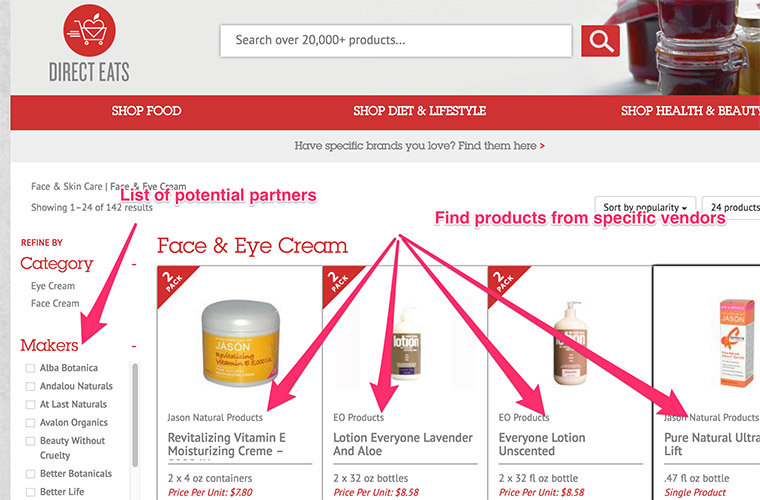
The best part? There are niche ecommerce websites for basically all niches that you see with subscription boxes:
- Health/Organic: Direct Eats, Thrive Market
- Baby: Diapers.com
- Fishing/Outdoors/: Bass Pro Shops, Gander Outdoors
- Geek/Gamer: ThinkGeek
- Beauty: Beauty.com, Beautybar.com
- Pet: Chewy, Pet Mountain
Note: Remember, don’t contact these sites directly. You can use them as a source of leads, then reach out to the product companies individually.
4. Etsy
Etsy is a marketplace for mostly small-/medium-sized businesses that often service handcrafted, vintage, and small-batch goods. Don’t let that fool you, though – Etsy’s robust categories of beauty, home goods, and even foodstuffs can mean a lengthy source of new vendors to work with for almost any subscription box.
Plus, Etsy offers great ways to narrow your searches and shop by specific categories. This can speed things up when you’re looking for something specific:
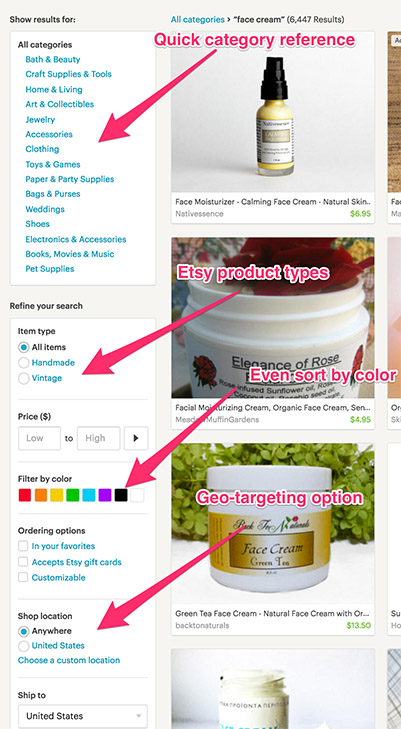
Tips:
- Etsy’s ability to allow you to narrow your search based on state, city, and country means you can target more local businesses. That means lower shipping costs to you.
- Be diligent. Etsy’s demographic skews far more toward novice/beginner when it comes to vendor business acumen compared to what you’ll find pre-vetted in chain stores or curated niche sites. That’s okay – just understand you might need to do a bit more handholding than with an established vendor.
Are you an Etsy seller yourself? Check out Cratejoy’s Etsy Calculator to see how a subscription box option can magnify your sales.
5. Alibaba/Indiamart
Alibaba, Indiamart and other global marketplaces offer extraordinarily low costs for bulk goods. And yes, this can include premade items that you can place in your boxes.
But this can depend a lot on which niche you serve. What’s more, these marketplaces usually serve indistinguishable products better than branded, American consumer-ready items – think packaging (bottles, jars, bags), light outdoor equipment, accessories, glasses & mugs, etc.
Tips:
- Be prepared for large minimums. If you’re looking for glass bottles, try to plan several projects with them, then order enough to hold you over. Most of these marketplaces aren’t useful for small orders (<500 units).
- Be wary. Look for buyer protection. If there is none, remember that PayPal offers buyer protection (if it’s within the Terms of Use), but you only have 45 days from the sale to claim. That might not even be enough time to receive the shipment.
- Make sure you order the correct case/quantity amounts. Items are listed with differing amounts, and long processing and shipping times can mean no time to rush extras.
Note: If you’re specifically looking for American manufacturing, MakersRow offers a database of leads.
6. Encourage Vendors to Contact YOU
Making it easy for vendors to offer submissions can be a simple way to generate warm leads for yourself. This usually becomes an option only after you’ve launched and established a presence, but once that has happened, you’ll likely find yourself fielding a few vendor requests each week.
Tips:
- Create a custom vendor request form or contact page and add a link to your site’s footer.
- Make it easy for vendors to download or otherwise access resources about you. Have a media kit or brand invitation available through a download link on your vendor contact page, or have it send out automatically once someone reaches out to the specific email you use to field requests (i.e. brands@yourcompany.com).
- Get active on Facebook groups or online communities full of targeted vendors. Finding where your vendors spend time online networking with each other and posting there can help generate tons of leads. Consider doing a Facebook group search for your targeted vendor type, like “Etsy stores.”
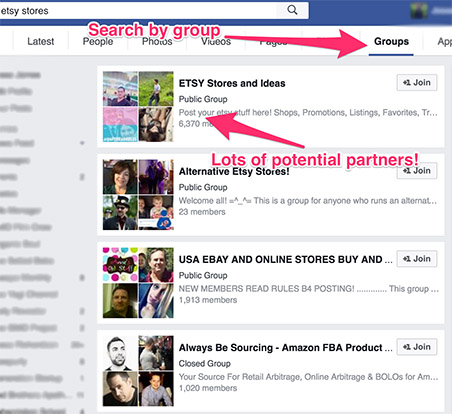
7. Buy Wholesale from Big Name Brands
Sourcing products from well-known companies may seem daunting, but you’d be surprised how many consumer giants offer wholesale products made deliberately with business owners like you in mind. For example, JOANN Fabrics has a huge variety of bulk items perfect for craft or maker subscription boxes.
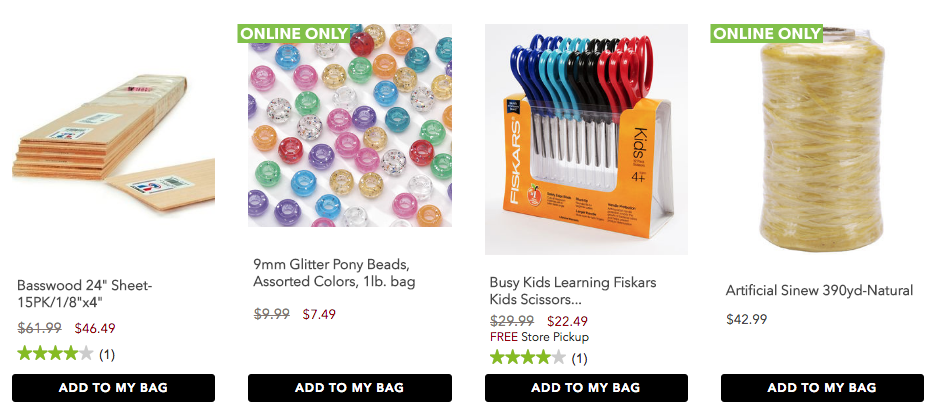
The best part of buying wholesale from reputable distributors is product quality and positive name association. Say, for example, you’re sourcing for a quilting box. Imagine that in your next month’s shipment, you’re able to include an insert that says this month’s material was sourced by JOANN Fabrics! This brand recognition can instill positive feelings in your subscriber base and a perception of higher value, quality, and legitimacy.
Experiment: Run the numbers on sourcing with our Subscription Box Pricing Guide and Startup Costs Calculator.
Subscription Box Product Sourcing
Sourcing products doesn’t need to stop with these approaches. In fact, there are several other ways to find brand partners: like trade shows & conventions, using distributors’ catalogs, and even being the source of your own products. Whatever the approach used, the goal is the same – to give yourself exposure and access to brand partners that will resonate with your target demographic and ensure a superior customer experience.
Now that you’ve got your products sourced, make sure you have a box to put them in. Check out the options from Cratejoy’s partnership with BoxUp!
Which methods do you use for product sourcing, and what challenges have you face? Let us know in the comments below.
Want even more? Connect with over 10,000 subscription box entrepreneurs like you in the Subscription School Private Facebook Group
Cratejoy is an all in one subscription commerce platform that includes everything you need to start your own subscription commerce business online. Try it free for 14 days.

